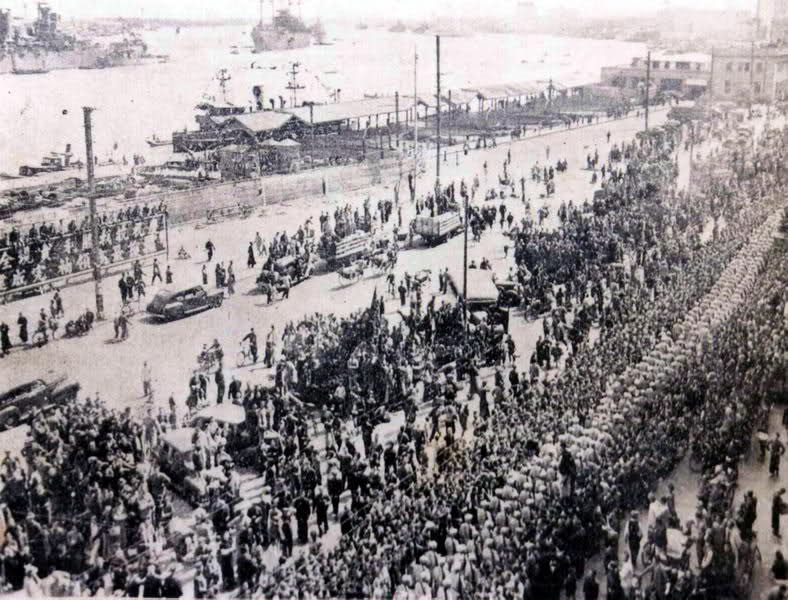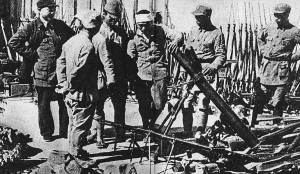The Takeover of Shanghai, 1945
- By Guest blogger
- 7 October, 2015
- No Comments

This article is part of a large online project — End of Empire — launched by the Nordic Institute of Asian Studies (NIAS). The idea is simple: To describe day by day the 100 days immediately after Hiroshima. This article, written by Li Lin, is reproduced with the kind permission of NIAS. Check out End of Empire here or the Facebook page here.
On 13 August 1937, Japanese troops and armadas launched a concerted onslaught on Shanghai. After resisting for three months, the Chinese Nationalist army retreated and, with the exception of the ‘isolated islets’ of the International Settlement and the French Concession, the city was occupied by the Japanese. When Japan bombed the Pearl Harbor on 8 December 1941, simultaneous military actions intruded into the International Settlement, after which the entire city was controlled by the Japanese and their puppet agents. Events in Hiroshima convinced all parties that Japanese days in Shanghai were numbered, its future was uncertain. As happened throughout Asia, interest articulations by national leaders often were at odds with capability and willingness on the ground.
On 9 August 1945, the day the United States dropped their atomic bomb on Nagasaki and the Soviets plunged into Manchuria, the Communist Party of China’s (CPC) central committee decided to attack and occupy Shanghai with its New Fourth Army, but finally gave in view of the strength disparity compared with the KMT in this region. However, the CPC’s underground networks survived and even expanded during the battle and contributed to the successful communist macro-strategy: ‘surrounding the city with countryside’.
The KMT, for its part, quickly developed a comprehensive arrangement for this vital metropolis. On 13 August, the Nationalist government in Chungking appointed Ch’ien Ta-chun mayor of Shanghai, who arrived to assume his duty one month later. General T’ang En-po was assigned to ensure peace, stability and, most important, KMT control in the Nanking-Shanghai region, as a part of Chiang Kai-Shek’s national troop relocation in preparation for takeover of territories occupied by the Japanese. American aircraft and vessels supported these troop movements but sheer distance and logistical challenges meant that proper occupation of Shanghai would not be achieved soon. Hence, Chiang commanded Chou Fo-hai, wartime Shanghai’s puppet mayor, to maintain the order in the interim, with the assistance of the surrendered Japanese army as well as the KMT’s underground agents. Chiang was not in a position to fully enforce this order. Chou Fo-hai believed (correctly) that his collaboration with the Japanese would cost him his life. Prominent members of the puppet government, including Ch’en Kung-po, Yuan Lu-teng, Lin K’ang-hou and several others were to meet the same fate or perhaps face imprisonment and property confiscation.
Throughout the course of the takeover, disorder and corruption were rampant and officials of different backgrounds, officers from all ranks, and even merchants and bandits backed by otherwise-competing powers pursued individual and collective agendas that would baffle any sense of rationality beyond Shanghai’s borders. When news of this violence, chaos, and corruption reached Chiang Kai-shek in Chungking, he reproached the newly appointed mayor and sent T. V. Soong, President of the Executive Yuan, to supervise the takeover affairs in Shanghai except those pertaining to military aspects. However such prevailing intrigues were not thus stopped, which severely undermined KMT’s governance after the war.
On 12 September, five days after T’ang En-po arrived Shanghai, the Nationalist government replaced the puppet government’s currency with Nationalist legal tender and set a predatory exchange rate of 200:1. In addition, the excessive volume of the new currency led to hyperinflation and further worsened the economic situation in Shanghai. The Nationalists would pay the price for these errors a few years later.
Since the Allies had renounced their treaty rights in China during the war, foreign concessions in Shanghai were not restored after Japan’s defeat. For the first time since the signature of the Treaty of Nanking in 1842, the city was entirely administered by the Chinese. The assets and industries, except those confiscated as of the enemy’s, were returned to their due owners after the war. The end of the war liberated not only 3.5 million Chinese residents in this city but also more than 6,000 European, American and Australian citizens interned in the Civil Assembly Center, and nearly 23,000 Jewish refugees in the Shanghai Ghetto who had escaped from The Holocaust.




 Copyright © 2024
Copyright © 2024
Leave a Reply